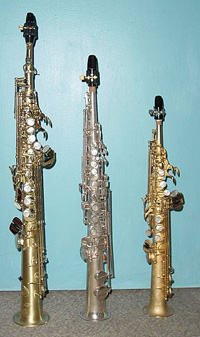Not to be confused with soprano saxophone or C melody saxophone.
| This article needs additional citations for verification. Please help improve this article by adding citations to reliable sources. Unsourced material may be challenged and removed. Find sources: "C soprano saxophone" – news · newspapers · books · scholar · JSTOR (February 2008) (Learn how and when to remove this message) |
 B♭ soprano saxophone (left), silver-plated C soprano saxophone (center), E♭ sopranino saxophone (right). B♭ soprano saxophone (left), silver-plated C soprano saxophone (center), E♭ sopranino saxophone (right). | |
| Woodwind instrument | |
|---|---|
| Classification | Single-reed |
| Hornbostel–Sachs classification | 422.212-71 (Single-reed aerophone with keys) |
| Inventor(s) | Adolphe Sax |
| Developed | 1840s |
| Playing range | |
 Soprano saxophone in C sounds as written. Soprano saxophone in C sounds as written. | |
| Related instruments | |
|
Sizes:
Orchestral saxophones: Specialty saxophones: | |
| Musicians | |
| See list of saxophonists | |
The C soprano saxophone is a member of the saxophone family, invented in 1846. It closely resembles the more common B♭ soprano saxophone but is pitched a whole step higher. Unlike most other saxophones, it is not a transposing instrument, a quality it shares with the C melody (also called C tenor) saxophone. The C soprano has a very similar range to the oboe.
As with C melody saxophones, American production of C sopranos commenced circa 1919 and ended around 1929. The same companies that made C melody instruments manufactured C soprano saxophones, and they were marketed to those who wished to perform oboe parts in military bands, vaudeville arrangements, or church hymnals. C sopranos made by some French manufacturers exist but are exceedingly rare.
In the early 2010s, the New Zealand–based company Aquilasax contracted a factory in China to produce C sopranos, with modern keywork but a bore copied from C.G. Conn's 1920s model. These received a very mildly positive response from players and technicians who encountered them, but demand was low and only a small number was produced. Aquilasax is now defunct, and the factory that produced these instruments is no longer operational.
C sopranos are the same shape as B♭ sopranos and differ in length by only around 3 centimeters. Nearly all vintage examples are keyed from low Bb to high Eb. Aquilasax's 2010s models were keyed to high F and F#. C soprano saxophones usually have a "C" stamped on them, close to the serial number.
In classical music
The C soprano saxophone was written for by Richard Strauss in his Sinfonia Domestica, where included in the music are parts for four saxophones including a soprano saxophone in C.
Notes
- "Aquilasax Celeste ii C soprano saxophone review". www.shwoodwind.co.uk. Retrieved 11 May 2022.
| Types of saxophones | |
|---|---|
|
This article relating to single-reed instruments is a stub. You can help Misplaced Pages by expanding it. |